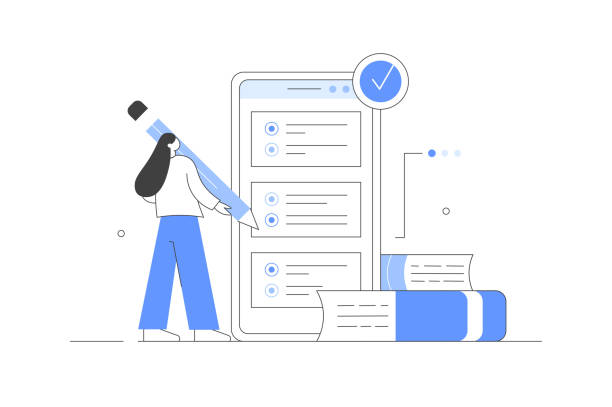The Critical Importance of Secure Website Design in the Digital Age

In today’s world, where all businesses and communications have shifted to the online space, secure website design is no longer an option, but an undeniable necessity.
With the increasing rise of cyber threats, data loss, phishing attacks, and malware, maintaining website security is of paramount importance.
An insecure website can lead to loss of customer trust, irreparable damage to brand reputation, and even heavy legal penalties.
Therefore, #cybersecurity must be considered from the outset in all stages of #web_design and development of a website.
This preventive approach is far more effective and less costly than attempting to repair damages after attacks occur.
Cybersecurity not only guarantees the protection of sensitive user data but also ensures the stability and uninterrupted performance of the website.
This section provides an overview and educational insight into why secure website design is important, explaining the fundamental basis of this pressing need.
User trust is the cornerstone of any successful online business, and this trust is only gained by providing a secure and reliable user experience.
Paying attention to security aspects from the very beginning is an integral part of secure web design.
Are you tired of your company’s website not meeting your expectations? With Rasawweb, design a professional website that truly represents your business.
✅ Increase attraction of new customers and sales leads
✅ Enhance your brand’s credibility and trust among your audience
⚡ Get a free website design consultation!
Fundamental Principles of Web Security and Its Role in Website Design

To achieve secure website design, understanding and implementing the fundamental principles of web security is essential.
These principles include areas such as Input Validation, Strong Authentication mechanisms, proper Session Management, and precise Access Control.
Every piece of code, every library, and every part of the website’s infrastructure must be designed and implemented with Defense in Depth in mind.
This approach means multiple defensive layers that, even if one layer is breached, other layers prevent complete penetration.
Secure coding and using web development frameworks that have security principles at their core are among the specialized guidelines that developers must adhere to.
Validating all user inputs and filtering them to prevent the injection of malicious code is one of the most vital measures in preventing common attacks such as SQL Injection and XSS.
Secure website design emphasizes that security should not be an afterthought, but rather incorporated into all details from the initial design phase.
Creating a secure website requires deep technical knowledge and strict adherence to these principles.
Identifying Common Vulnerabilities and Preventive Solutions

Websites are constantly exposed to various types of vulnerabilities that attackers can exploit.
Identifying these vulnerabilities and implementing preventive solutions is a key step in secure website design.
Among the most common vulnerabilities are SQL Injection, Cross-Site Scripting (XSS), Cross-Site Request Forgery (CSRF), Broken Authentication, and Security Misconfiguration.
Precise analysis of each of these weaknesses and understanding how they can be exploited helps developers build stronger defensive systems.
For example, to prevent SQL Injection, using Prepared Statements and parameterizing inputs is essential.
For XSS, all user inputs and outputs must be carefully filtered and encoded.
Secure website design emphasizes that every part of the application must be examined for potential misuse.
The challenging content here is: Do we sufficiently understand how even a single line of insecure code can compromise the entire system? Below, a table of common vulnerabilities and their prevention strategies is provided:
| Vulnerability | Description | Prevention Strategy in Secure Website Design |
|---|---|---|
| SQL Injection | Injecting malicious SQL code into the database via user inputs | Using Prepared Statements and parameterization for all database queries |
| XSS (Cross-Site Scripting) | Injecting malicious JavaScript code into web pages that are executed by the user’s browser | Thorough validation and filtering of all user inputs and outputs (HTML Encoding) |
| Broken Authentication | Weaknesses in authentication mechanisms such as weak passwords or improper session management | Implementing strong authentication, using Multi-Factor Authentication (MFA), and proper session management |
| Insecure Deserialization | Lack of input data validation in the object serialization and deserialization process | Avoiding deserialization of insecure data and using safer formats for data exchange |
SSL/TLS Certificates: The Backbone of Communication Security

One of the most basic yet vital steps in secure website design is the use of SSL/TLS certificates.
SSL/TLS (Secure Sockets Layer/Transport Layer Security) is a protocol that encrypts communication between the user’s browser and the website server.
This encryption ensures that no third party can eavesdrop on or tamper with the exchanged information (such as login credentials, credit card details, or personal data).
Websites that use SSL/TLS begin with the prefix “https://” instead of “http://” and display a green padlock in the browser’s address bar, assuring users.
In addition to enhancing security, using HTTPS also has SEO benefits, as search engines like Google rank SSL-enabled websites higher.
There are various types of SSL certificates, including Domain Validated (DV), Organization Validated (OV), and Extended Validation (EV) certificates, each offering a different level of validation and trust.
Explaining how they work and guidance on choosing the appropriate certificate is an integral part of the website securing process.
Did you know that poor online store design can drive away up to 70% of your potential customers? Rasawweb transforms your sales with professional and user-friendly e-commerce website designs.
✅ Significant increase in sales and revenue
✅ Full optimization for search engines and mobile
⚡ [Get a free consultation from Rasawweb]
Protecting Databases and Sensitive User Data

The heart of any website is its database, which contains vital information, including sensitive user data.
Therefore, protecting this data is considered one of the most important aspects of secure website design.
To ensure database security, multiple layers of protection must be implemented.
This includes data encryption, both in transit and at rest.
Precise access control mechanisms must be defined so that only authorized users and applications can access the data.
Using strong passwords and regularly updating them for database accounts, as well as implementing IP restrictions for access to the database server, are essential security measures.
Also, performing regular backups of the database and storing them in a secure, offline location is vital for data recovery in the event of a disaster or cyber attack.
Thorough cleaning and validation of data before storing it in the database helps prevent many data-driven attacks.
This section examines the most specialized approaches to data protection within the framework of secure website architecture.
The Role of Firewalls and Intrusion Detection Systems in Layered Defense

In the secure website design strategy, implementing a layered defense is of high importance, and firewalls and Intrusion Detection Systems (IDS/IPS) play a key role in this area.
Firewalls act as the first line of defense and prevent unauthorized access to website servers by monitoring and filtering network traffic.
Web Application Firewalls (WAFs) are also specifically designed to protect web applications against common attacks such as SQL Injection and XSS.
On the other hand, Intrusion Detection Systems (IDS) and Intrusion Prevention Systems (IPS) are used, respectively, for identifying and preventing malicious activities.
IDS monitors network traffic and system activities, identifies suspicious patterns, and issues alerts, while IPS can automatically take necessary actions to block threats.
Training on how to correctly select and configure these tools to optimize website security is essential.
This layered approach, known as “defense in depth”, ensures that even if one security layer is breached, subsequent layers will prevent attackers from entering.
This is an important and explanatory aspect towards designing a website with a secure structure.
The Importance of Updates and Security Patch Management
![]()
One of the biggest security weaknesses in websites is the lack of regular updates for software and systems.
Attackers constantly look for known vulnerabilities in operating systems, CMSs (such as WordPress, Joomla), plugins, themes, and third-party libraries.
Therefore, proper security patch management and regular updates are considered a vital component of secure website design.
This process involves continuous monitoring for new patches, prioritizing them based on urgency, and then applying them in a controlled and test environment before deployment to the production environment.
News regarding new vulnerabilities and their released patches must be closely followed.
Many successful cyber attacks occur due to the failure to apply simple updates.
This section provides practical guidance for creating a robust and proactive patch management program to ensure that the website is always protected against the latest threats.
Maintaining website security is an ongoing process, and keeping systems up-to-date is of paramount importance.
Below, a table of best practices for security patch management is provided:
| Step | Description | Why it matters? |
|---|---|---|
| Regular Monitoring | Continuous checking for new patches for operating systems, CMSs, plugins, and libraries | Ensuring timely awareness of vulnerabilities and security updates |
| Prioritization | Assessing the urgency and impact of patches based on risk level and exploitation potential | Allocating resources to the most critical and urgent updates |
| Test Deployment | Installing patches in a non-production environment (Staging/Dev) before applying them to the main site | Preventing the creation of new functional or security issues in the production environment |
| Backup | Creating a full backup of the entire system and database before any major update | Enabling quick rollback to the previous state in case of an unexpected issue or error |
User Education and Fostering a Culture of Cybersecurity

In addition to the technical aspects of secure website design, the human factor also plays a very important role in overall website security.
Even the most secure systems can become vulnerable if users and administrators lack awareness and training.
Educating users about common threats such as phishing, social engineering attacks, and the importance of using strong and unique passwords is essential.
Creating a culture of security awareness within the organization and among website users is a long-term investment in security.
Encouraging the use of Two-Factor Authentication and educating on how to identify suspicious emails and links can significantly reduce the risk of attacks.
Engaging and continuous training can help increase this awareness.
This educational section emphasizes that a secure website is not limited to secure coding and infrastructure; it also depends on the security understanding and behavior of all individuals interacting with it.
Secure website design should include planning for continuous training of staff and users.
Does your current website build the trust that potential customers should have in your business? If the answer is no, it’s time to get your professional and impactful corporate website with Rasawweb.
✅ Fully customized design tailored to your brand identity
✅ Increase lead generation and your business’s credibility in the eyes of customers⚡ Contact us for a free consultation!
Penetration Testing and Periodic Security Audits

After implementing all security measures, the main challenge is to ensure whether these measures are working correctly and if any weaknesses remain. This is where Penetration Testing and periodic security audits come in.
Penetration testing involves simulating cyberattacks by security professionals (ethical hackers) to identify vulnerabilities before real attackers can exploit them.
This analytical and specialized approach includes vulnerability scanning, configuration review, and attempts to bypass defensive mechanisms.
Periodic security audits also involve a comprehensive evaluation of security policies, processes, and controls to ensure that the website complies with security standards and best practices.
These preventive activities help identify and address weaknesses that may arise over time or with system changes.
Secure website design is not a static process, but a continuous improvement cycle of which testing and review are essential parts.
These tests and audits ensure that website security is maintained over time and evolves with new threats.
The Future of Secure Website Design: Challenges and Emerging Trends

With technological advancements, the landscape of cyber threats is constantly changing, which creates new challenges for secure website design.
Emerging trends such as Artificial Intelligence (AI) and Machine Learning (ML) can play a role both in strengthening cyber defense and in making attacks more complex.
The security of Internet of Things (IoT), the rise of ransomware attacks, and the need to protect data privacy in the face of regulations like GDPR and CCPA are just some of the challenges ahead.
Analyzing these challenges and predicting future trends is essential for secure website design specialists to develop innovative solutions.
The challenging content here is: Can the pace of security solution development keep up with the pace of threat evolution? The future of a secure website depends on a commitment to continuous research and development and international cooperation to combat common threats.
This forward-looking perspective completes the process of secure website design from start to finish and demonstrates that security is an ongoing journey.
Frequently Asked Questions
| Row | Question | Answer |
|---|---|---|
| 1 | What is secure website design? | Secure website design is a process in which websites are built with security measures in mind from the initial development stages to protect against cyberattacks, unauthorized access, and data loss. |
| 2 | Why is secure website design important? | Website security is vital for maintaining user trust, protecting sensitive information (personal and financial), preventing damage to brand reputation, and complying with privacy and security regulations (such as GDPR). A security breach can lead to financial and legal damages. |
| 3 | What are the most common cyberattacks a website faces? | Some of the most common attacks include SQL Injection, Cross-Site Scripting (XSS), Distributed Denial of Service (DDoS), Brute Force, and credential-based attacks (Credential Stuffing). |
| 4 | What is SQL Injection and how to prevent it? | SQL Injection is a type of attack where an attacker attempts to manipulate the database or extract information by injecting malicious SQL code into site inputs. To prevent it, one should use Prepared Statements/Parameterized Queries, ORM (Object-Relational Mapping), and rigorous input validation. |
| 5 | What is Cross-Site Scripting (XSS)? | XSS is a type of attack where an attacker injects malicious scripts (usually JavaScript) into web pages, which are then executed by other users’ browsers. This can lead to cookie theft, session information theft, or alteration of the website’s appearance. |
| 6 | How can Brute Force attacks on login pages be prevented? | To prevent Brute Force attacks, one should use CAPTCHA, limit the number of failed login attempts (Account Lockout), implement Two-Factor Authentication (2FA), and use complex and long passwords. |
| 7 | What is the role of HTTPS in website security? | HTTPS encrypts communication between the user’s browser and the website server using SSL/TLS. This prevents eavesdropping, tampering, or forging of information during transmission and increases user trust. |
| 8 | What is the importance of Input Validation in security? | Input Validation is the process of examining and sanitizing data entered by the user. This prevents the injection of malicious code, XSS attacks, SQL Injection, and other vulnerabilities, ensuring that the data conforms to the expected format. |
| 9 | Why are regular updates for website systems and software essential? | Regular updates for the operating system, CMS (like WordPress), plugins, themes, and libraries used, fix known security vulnerabilities. Hackers often exploit weaknesses in outdated software for penetration. |
| 10 | What role do regular backups play in secure website design? | Regular and tested backups of website information (database and files) are a critical layer of defense against data loss due to cyberattacks, human error, or hardware failure. This allows for quick website recovery in the event of a disaster. |
And other services of Rasawweb Advertising Agency in the field of advertising
Benefits of placing ads on multiple industrial websites
How to use industrial customer feedback to improve ads
Techniques for increasing conversion rates in medical equipment advertisements
How to display quality certificates in advertisements
The role of safety specifications in the sale of advanced medical equipment
And over hundreds of other services in the field of internet advertising, advertising consultation, and organizational solutions
Internet Advertising | Advertising Strategy | Advertorial
🚀 With Rasawweb Afarin, your business will soar in the digital world! From SEO and targeted content creation to multilingual website design and advertising campaign management, we are with you every step of your digital growth journey to ensure a powerful and lasting presence.
📍 Tehran, Mirdamad Street, next to Bank Markazi, Southern Kazeroon Alley, Ramin Alley, No. 6

